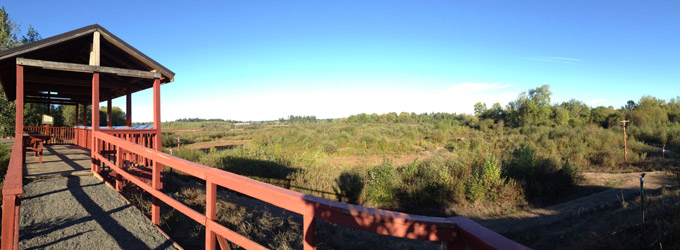
The History of Jackson Bottom
Jackson Bottom has always been a special place. Native peoples used the rich bottom lands to gather food and to hunt. Waterfowl passed through in great numbers. Early settlers homesteaded the uplands. Unfortunately, lack of understanding led to years of abuse and degradation of the wetlands. The wetlands were ditched and drained for agricultural purposes, cattle grazed on the native vegetation, and the wetlands were used over time for disposal of cannery wastes and construction debris.
The Jackson Family
Hyer Jackson, born in 1806, married Elizabeth Craig in 1831 and studied law in West Virginia, passing the bar in 1836. They moved to Indiana and in 1854 followed Hyer’s brothers and sister to Oregon. Hyer obtained land through the Oregon Donation Land Law. He wanted the site by the Tualatin River so he could establish a steamboat landing for the purpose of transportation of people and farm produce, although he was not a farmer. While he was Country Treasurer, he died of a heart attack in 1873. Read more about Hillsboro’s Jackson Family.
In 1910 the City of Hillsboro installed sewers in the downtown area which were connected to a septic tank located in the north end of Jackson Bottom. In 1935 the City constructed a sewage treatment plant along Highway 219 to replace the inadequate earlier system.
By the 1930s Hillsboro’s population had reached approximately 3,500 people and its economy was centered on cannery and lumbering activities. Cannery wastes were discharged directly into the Tualatin River, polluting the river to such an extent that the dairy farmers could no longer use the river water for their herds.
Many farmers were incensed about river pollution and at least a few threatened to sue the city. With the effects of the Depression prevalent in Oregon, money was tight and the City leaders were hesitant to take action against the canneries. In 1939 the largest cannery, Maling & Company, purchased the 120-acre Trent farm to eliminate the most vocal opponent of river pollution. The farm was then resold to the City and became the first publicly owned property in Jackson Bottom.
Pressure to Clean Up the Waste
State and local pressure to clean up cannery waste increased and by 1945 the City of Hillsboro started experimenting with land disposal techniques. James Burns, the operator of the Hillsboro Sewer Farm from 1935 to 1969, returned from his World War II service in the U.S. Army Corps of Engineers with many innovative ideas about land disposal. He experimented with intermittent flooding, spray irrigation, crop production and pasture enhancement.
These activities proved successful and at one time the sewer farm employed over 200 people to grow, harvest, and process crops grown on the farm. At its peak, the project produced a $36,000 profit for the City. Additional private properties were acquired over the years and by 1956 the City owned most of the Jackson Bottom east of Highway 219. The City continued to operate the sewer farm into the early 1970s. Once intensive farming ceased, reed canary grass took over the area and was allowed to become pasture land.
Caring People and Important Partnerships
The 1970s also spawned a lengthy chronicle of caring people working hard and forming important partnerships to restore the Preserve to an area of growing beauty and productivity. Dedicated individuals known as the Friends of Jackson Bottom began a number of projects to improve the wetlands and increase wildlife habitat. In 1989 the Jackson Bottom Coordinated Resource Management Plan was completed to fulfill the goals identified by the Jackson Bottom Steering Committee. This plan encouraged the creation of ponds for wildlife enhancement in Jackson Bottom. To improve conditions, ponds were constructed, forage and shelter vegetation planted, nesting boxes constructed, and gambusia fish placed in the ponds to control mosquitoes.
The Friends of Jackson Bottom merged efforts and energies with the Steering Committee which obtained non-profit status in 1997. Soon after, one governing body with a common vision emerged — the Jackson Bottom Wetlands Preserve Board. September 2003 marked the Board’s successful completion of a $2.5 million dollar capital campaign to build the Wetlands Education Center.
Today, Jackson Bottom Wetlands Preserve is managed under the City of Hillsboro Parks & Recreation Department helping to provide diverse, innovative and exceptional recreational and cultural opportunities for the public.


